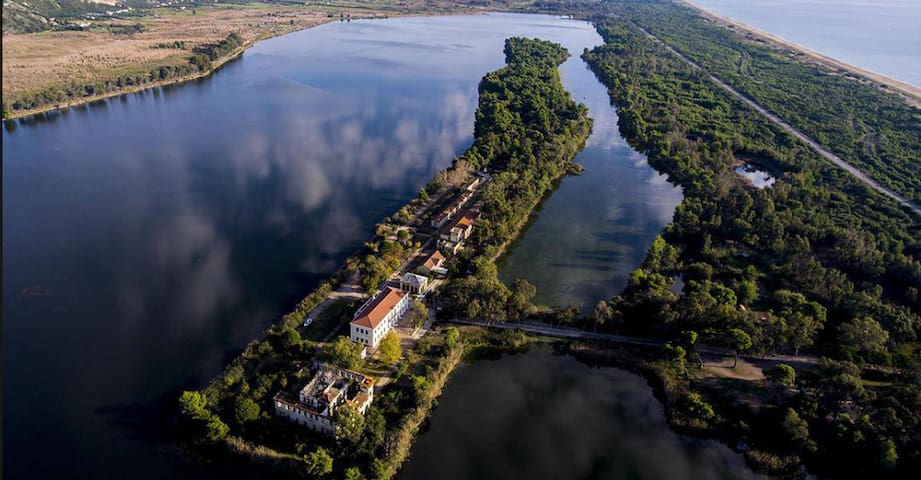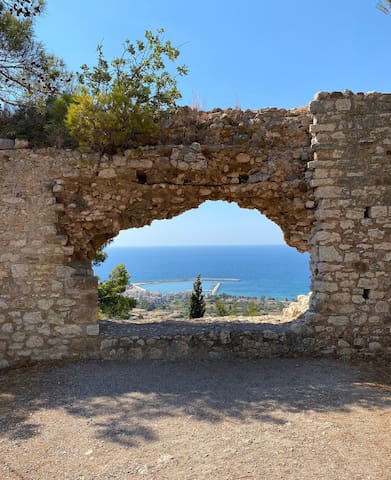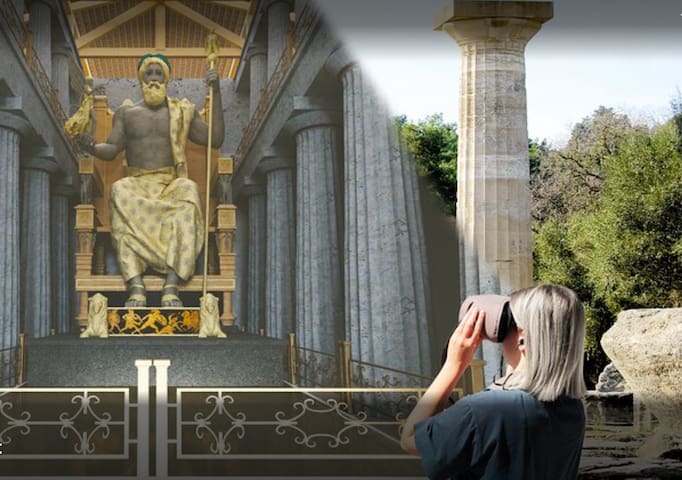Sightseeing
Neda is a 32 kilometers long river in the western Peloponnese. It's a natural boundary among the prefectures of Messenia and Ilia. The sources of Neda River are on the southern slope of Mount Lyceo. It flows through a beautiful gorge of barren rock and forests and empties into the Gulf of Kyparissia, a bay of the Ionian Sea, near the village of Zacharo. Along its course there are numerous of waterfalls forming stunning lakes with crystal clear water. The largest waterfall is near Figalleia and has a height of about 25 meters. The Neda river is one of the two rivers in Greece named after a female.
The easiest way to reach the waterfalls is through a narrow trail starting at an old stone bridge near the village of Platania. It only takes around 15 minutes to reach the first waterfall with a pool of unbelievably emerald water inviting for a swim. But it's not only this. There is another, even more picturesque waterfall further up as well as a charming little chapel of Panagia clinging to the cliffs. The path to the chapel starts just before the main waterfall. Walking the trail needs attention because it is narrow with slippery moss on the stones and with no guardrails. It is an amazing place to visit and swim on the natural swimming pools created by the numerous waterfalls of the area.
55 Recomendado por los habitantes de la zona
Cascadas de Neda
Neda is a 32 kilometers long river in the western Peloponnese. It's a natural boundary among the prefectures of Messenia and Ilia. The sources of Neda River are on the southern slope of Mount Lyceo. It flows through a beautiful gorge of barren rock and forests and empties into the Gulf of Kyparissia, a bay of the Ionian Sea, near the village of Zacharo. Along its course there are numerous of waterfalls forming stunning lakes with crystal clear water. The largest waterfall is near Figalleia and has a height of about 25 meters. The Neda river is one of the two rivers in Greece named after a female.
The easiest way to reach the waterfalls is through a narrow trail starting at an old stone bridge near the village of Platania. It only takes around 15 minutes to reach the first waterfall with a pool of unbelievably emerald water inviting for a swim. But it's not only this. There is another, even more picturesque waterfall further up as well as a charming little chapel of Panagia clinging to the cliffs. The path to the chapel starts just before the main waterfall. Walking the trail needs attention because it is narrow with slippery moss on the stones and with no guardrails. It is an amazing place to visit and swim on the natural swimming pools created by the numerous waterfalls of the area.
The healing properties of the Kaiafas lake waters have been known since antiquity; according to the ancient Greeks, they owed their properties to the nymphs who inhabited the forests surrounding the area. For that reason they honoured them with great piety, erecting splendid temples and sanctuaries in their name.
Those visiting Kaiafas lake today do so not only for the water therapy, but also to admire the unique natural landscape and to do activities such as sea sports, which are offered in the area. The beautiful, serene nature also sets the scene for total relaxation, away from the city’s rapid pace.
This hydrotherapy centre is responsible for attracting many tourists in the area, of all ages and from all over the world. The healing waters are rich in hydrogen sulphide and their temperature remains stable at 20-30 °C between May and October, which is the most suitable period for water therapy.
Kaiafas, of cource, isn’t good only for water therapy; many also come here to enjoy the enchanting landscape, with the emerald-green sea, the beach with the sand dunes and the unique vegetation surrounding the lake. It is not a coincidence that the lake has been declared a protected area.
31 Recomendado por los habitantes de la zona
Kaiafas Lake
The healing properties of the Kaiafas lake waters have been known since antiquity; according to the ancient Greeks, they owed their properties to the nymphs who inhabited the forests surrounding the area. For that reason they honoured them with great piety, erecting splendid temples and sanctuaries in their name.
Those visiting Kaiafas lake today do so not only for the water therapy, but also to admire the unique natural landscape and to do activities such as sea sports, which are offered in the area. The beautiful, serene nature also sets the scene for total relaxation, away from the city’s rapid pace.
This hydrotherapy centre is responsible for attracting many tourists in the area, of all ages and from all over the world. The healing waters are rich in hydrogen sulphide and their temperature remains stable at 20-30 °C between May and October, which is the most suitable period for water therapy.
Kaiafas, of cource, isn’t good only for water therapy; many also come here to enjoy the enchanting landscape, with the emerald-green sea, the beach with the sand dunes and the unique vegetation surrounding the lake. It is not a coincidence that the lake has been declared a protected area.
The Medieval Castle of Kyparissia: The Castle of Kyparissia is also known as the Castle of Arcadia, which is the medieval name of the town. It is one of the most known sights in Kyparissia and stands as a stronghold of the entire municipality. According to researchers, the Castle of Kyparissia was built by Frankish people on the site of a previous Byzantine fortress.
22 Recomendado por los habitantes de la zona
Kyparissia Castle
The Medieval Castle of Kyparissia: The Castle of Kyparissia is also known as the Castle of Arcadia, which is the medieval name of the town. It is one of the most known sights in Kyparissia and stands as a stronghold of the entire municipality. According to researchers, the Castle of Kyparissia was built by Frankish people on the site of a previous Byzantine fortress.
On the bare rocky slopes of Mount Kotilio stands one of the most important and imposing temples of antiquity, dedicated to Apollo Epikourios (“Apollo the Helper”).. The temple is situated in a prominent position and is on the U.N.E.S.C.O. list of World Cultural Heritage sites along with the Egyptian Pyramids, the Parthenon and other monuments worldwide.
The temple was dedicated to Apollo Epikourios by the inhabitants of Figalia because they overcame a plague epidemic. The inhabitants of Figalia had erected a temple in honour of Apollo Vassita in the 7th century B.C., and worshipped him with the name Epicure supporter in war or illness. He was given the name Epicurean during the wars against the Spartans around 650 B.C. The final Temple was built during the second half of the 5th century BC (420-410) by Iktino who was also the architect of the Parthenon and for this reason is sometimes referred to as the Parthenons Twin.
53 Recomendado por los habitantes de la zona
Temple of Apollo Epikourios
On the bare rocky slopes of Mount Kotilio stands one of the most important and imposing temples of antiquity, dedicated to Apollo Epikourios (“Apollo the Helper”).. The temple is situated in a prominent position and is on the U.N.E.S.C.O. list of World Cultural Heritage sites along with the Egyptian Pyramids, the Parthenon and other monuments worldwide.
The temple was dedicated to Apollo Epikourios by the inhabitants of Figalia because they overcame a plague epidemic. The inhabitants of Figalia had erected a temple in honour of Apollo Vassita in the 7th century B.C., and worshipped him with the name Epicure supporter in war or illness. He was given the name Epicurean during the wars against the Spartans around 650 B.C. The final Temple was built during the second half of the 5th century BC (420-410) by Iktino who was also the architect of the Parthenon and for this reason is sometimes referred to as the Parthenons Twin.
Visit the ruins of Ancient Olympia with a prebooked ticket for a virtual reality (VR) tour. With a special VR headset, the history of the UNESCO-listed archaeological site comes to life and you'll experience the ruins as they were in bygone days. Listen to the integrated audio guide for the lowdown on sights like the Temple of Zeus and the stadium as you stroll.
Know before you go
Duration: 2-3 hours
Mobile tickets accepted
Instant confirmation
Available languages
German, English, Italian, French, Dutch, Spanish
95 Recomendado por los habitantes de la zona
Museo Arqueológico de Olympia
Visit the ruins of Ancient Olympia with a prebooked ticket for a virtual reality (VR) tour. With a special VR headset, the history of the UNESCO-listed archaeological site comes to life and you'll experience the ruins as they were in bygone days. Listen to the integrated audio guide for the lowdown on sights like the Temple of Zeus and the stadium as you stroll.
Know before you go
Duration: 2-3 hours
Mobile tickets accepted
Instant confirmation
Available languages
German, English, Italian, French, Dutch, Spanish



